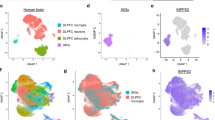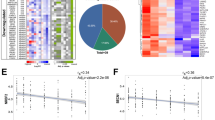Abstract
BACE1 encodes for the beta-site amyloid precursor protein cleaving enzyme 1 or β-secretase. Genetic deletion of Bace1 leads to behavioral alterations and affects midbrain dopaminergic signaling and memory processes. In order to further understand the role of BACE1 in brain function and behavior, we performed microarray transcriptome profiling and gene pathway analysis in the hippocampus of BACE1-deficient mice compared to wild type. We identified a total of 91 differentially expressed genes (DEGs), mostly enriched in pathways related to the immune and inflammation systems, particularly IL-9 and NF-κB activation pathways. Serum levels of IL-9 were elevated in BACE1-deficient mice. Our network analysis supports an intimate connection between immune response via NF-κB and BACE1 signaling through the NRG1/Akt1 pathway. Our findings warrant future mechanistic studies to determine if BACE1 signaling and the IL-9 pathway interact to alter behavior and brain function. This study opens new avenues in the investigation of hippocampus-related neuroimmunological and neuroinflammation-associated disorders.



Similar content being viewed by others
References
Vassar R, Bennett BD, Babu-Khan S, Kahn S, Mendiaz EA, Denis P, Teplow DB, Ross S et al (1999) Beta-secretase cleavage of Alzheimer’s amyloid precursor protein by the transmembrane aspartic protease BACE. Science 286(5440):735–741
Willem M, Lammich S, Haass C (2009) Function, regulation and therapeutic properties of beta-secretase (BACE1). Semin Cell Dev Biol 20(2):175–182. doi:10.1016/j.semcdb.2009.01.003
Hu X, Fan Q, Hou H, Yan R (2016) Neurological dysfunctions associated with altered BACE1-dependent neuregulin-1 signaling. J Neurochem 136(2):234–249. doi:10.1111/jnc.13395
Wolpowitz D, Mason TB, Dietrich P, Mendelsohn M, Talmage DA, Role LW (2000) Cysteine-rich domain isoforms of the neuregulin-1 gene are required for maintenance of peripheral synapses. Neuron 25(1):79–91
Taveggia C, Zanazzi G, Petrylak A, Yano H, Rosenbluth J, Einheber S, Xu X, Esper RM et al (2005) Neuregulin-1 type III determines the ensheathment fate of axons. Neuron 47(5):681–694. doi:10.1016/j.neuron.2005.08.017
Laird FM, Cai H, Savonenko AV, Farah MH, He K, Melnikova T, Wen H, Chiang HC et al (2005) BACE1, a major determinant of selective vulnerability of the brain to amyloid-beta amyloidogenesis, is essential for cognitive, emotional, and synaptic functions. J Neurosci Off J Soc Neurosci 25(50):11693–11709. doi:10.1523/JNEUROSCI.2766-05.2005
Savonenko AV, Melnikova T, Laird FM, Stewart KA, Price DL, Wong PC (2008) Alteration of BACE1-dependent NRG1/ErbB4 signaling and schizophrenia-like phenotypes in BACE1-null mice. Proc Natl Acad Sci U S A 105(14):5585–5590. doi:10.1073/pnas.0710373105
Paredes RM, Piccart E, Navaira E, Cruz D, Javors MA, Koek W, Beckstead MJ, Walss-Bass C (2015) Physiological and behavioral effects of amphetamine in BACE1(−/−) mice. Genes Brain Behav 14(5):411–418. doi:10.1111/gbb.12222
Wei C, Li J, Bumgarner RE (2004) Sample size for detecting differentially expressed genes in microarray experiments. BMC Genomics 5:87. doi:10.1186/1471-2164-5-87
Calvano SE, **ao W, Richards DR, Felciano RM, Baker HV, Cho RJ, Chen RO, Brownstein BH et al (2005) A network-based analysis of systemic inflammation in humans. Nature 437(7061):1032–1037. doi:10.1038/nature03985
Adhikari AS, Singh BN, Rao KS, Rao Ch M (2011) alphaB-crystallin, a small heat shock protein, modulates NF-kappaB activity in a phosphorylation-dependent manner and protects muscle myoblasts from TNF-alpha induced cytotoxicity. Biochim Biophys Acta 1813(8):1532–1542. doi:10.1016/j.bbamcr.2011.04.009
Ousman SS, Tomooka BH, van Noort JM, Wawrousek EF, O’Connor KC, Hafler DA, Sobel RA, Robinson WH et al (2007) Protective and therapeutic role for alphaB-crystallin in autoimmune demyelination. Nature 448(7152):474–479. doi:10.1038/nature05935
Ohno M, Cole SL, Yasvoina M, Zhao J, Citron M, Berry R, Disterhoft JF, Vassar R (2007) BACE1 gene deletion prevents neuron loss and memory deficits in 5XFAD APP/PS1 transgenic mice. Neurobiol Dis 26(1):134–145. doi:10.1016/j.nbd.2006.12.008
Cole SL, Vassar R (2007) The basic biology of BACE1: a key therapeutic target for Alzheimer’s disease. Curr Genomics 8(8):509–530. doi:10.2174/138920207783769512
Shao W, Zhang SZ, Tang M, Zhang XH, Zhou Z, Yin YQ, Zhou QB, Huang YY et al (2013) Suppression of neuroinflammation by astrocytic dopamine D2 receptors via alphaB-crystallin. Nature 494(7435):90–94. doi:10.1038/nature11748
Goswami R, Kaplan MH (2011) A brief history of IL-9. J Immunol 186(6):3283–3288. doi:10.4049/jimmunol.1003049
Ding X, Cao F, Cui L, Ciric B, Zhang GX, Rostami A (2015) IL-9 signaling affects central nervous system resident cells during inflammatory stimuli. Exp Mol Pathol 99(3):570–574. doi:10.1016/j.yexmp.2015.07.010
Neurath MF, Finotto S (2016) IL-9 signaling as key driver of chronic inflammation in mucosal immunity. Cytokine Growth Factor Rev 29:93–99. doi:10.1016/j.cytogfr.2016.02.002
van Noort JM, Bsibsi M, Gerritsen WH, van der Valk P, Bajramovic JJ, Steinman L, Amor S (2010) Alphab-crystallin is a target for adaptive immune responses and a trigger of innate responses in preactive multiple sclerosis lesions. J Neuropathol Exp Neurol 69(7):694–703. doi:10.1097/NEN.0b013e3181e4939c
Stassen M, Muller C, Arnold M, Hultner L, Klein-Hessling S, Neudorfl C, Reineke T, Serfling E et al (2001) IL-9 and IL-13 production by activated mast cells is strongly enhanced in the presence of lipopolysaccharide: NF-kappa B is decisively involved in the expression of IL-9. J Immunol 166(7):4391–4398
Xu J, Sun J, Chen J, Wang L, Li A, Helm M, Dubovsky SL, Bacanu SA et al (2012) RNA-Seq analysis implicates dysregulation of the immune system in schizophrenia. BMC Genomics 13(Suppl 8):S2. doi:10.1186/1471-2164-13-S8-S2
Dimitrov DH, Lee S, Yantis J, Valdez C, Paredes RM, Braida N, Velligan D, Walss-Bass C (2013) Differential correlations between inflammatory cytokines and psychopathology in veterans with schizophrenia: potential role for IL-17 pathway. Schizophr Res 151(1–3):29–35. doi:10.1016/j.schres.2013.10.019
Manu P, Correll CU, Wampers M, Mitchell AJ, Probst M, Vancampfort D, De Hert M (2014) Markers of inflammation in schizophrenia: association vs. causation. World Psychiatry 13(2):189–192. doi:10.1002/wps.20117
Woodard-Grice AV, McBrayer AC, Wakefield JK, Zhuo Y, Bellis SL (2008) Proteolytic shedding of ST6Gal-I by BACE1 regulates the glycosylation and function of alpha4beta1 integrins. J Biol Chem 283(39):26364–26373. doi:10.1074/jbc.M800836200
Baeuerle PA, Henkel T (1994) Function and activation of NF-kappa B in the immune system. Annu Rev Immunol 12:141–179. doi:10.1146/annurev.iy.12.040194.001041
Bonizzi G, Karin M (2004) The two NF-kappaB activation pathways and their role in innate and adaptive immunity. Trends Immunol 25(6):280–288. doi:10.1016/j.it.2004.03.008
Chen CH, Zhou W, Liu S, Deng Y, Cai F, Tone M, Tone Y, Tong Y et al (2012) Increased NF-kappaB signalling up-regulates BACE1 expression and its therapeutic potential in Alzheimer’s disease. Int J Neuropsychopharmacol 15(1):77–90. doi:10.1017/S1461145711000149
Keri S, Seres I, Kelemen O, Benedek G (2009) Neuregulin 1-stimulated phosphorylation of AKT in psychotic disorders and its relationship with neurocognitive functions. Neurochem Int 55(7):606–609. doi:10.1016/j.neuint.2009.06.002
Meng F, Liu L, Chin PC, D’Mello SR (2002) Akt is a downstream target of NF-kappa B. J Biol Chem 277(33):29674–29680. doi:10.1074/jbc.M112464200
Nicodemus KK, Law AJ, Radulescu E, Luna A, Kolachana B, Vakkalanka R, Rujescu D, Giegling I et al (2010) Biological validation of increased schizophrenia risk with NRG1, ERBB4, and AKT1 epistasis via functional neuroimaging in healthy controls. Arch Gen Psychiatry 67(10):991–1001. doi:10.1001/archgenpsychiatry.2010.117
Huang CH, Pei JC, Luo DZ, Chen C, Chen YW, Lai WS (2014) Investigation of gene effects and epistatic interactions between Akt1 and neuregulin 1 in the regulation of behavioral phenotypes and social functions in genetic mouse models of schizophrenia. Front Behav Neurosci 8:455. doi:10.3389/fnbeh.2014.00455
Acknowledgments
This work was supported in by a NARSAD Brain and Behavior Research Young Investigator award to CWB.
Author information
Authors and Affiliations
Corresponding author
Ethics declarations
Conflict of Interest
The authors declare that they have no conflict of interest.
Electronic Supplementary Material
Supplementary Figure S1
The relationship among significant networks enriched in the 91 differentially expressed genes (PNG 26 kb)
Supplementary Table 1
Differentially expressed genes (DOCX 24 kb)
Rights and permissions
About this article
Cite this article
Stertz, L., Contreras-Shannon, V., Monroy-Jaramillo, N. et al. BACE1-Deficient Mice Exhibit Alterations in Immune System Pathways. Mol Neurobiol 55, 709–717 (2018). https://doi.org/10.1007/s12035-016-0341-1
Received:
Accepted:
Published:
Issue Date:
DOI: https://doi.org/10.1007/s12035-016-0341-1




